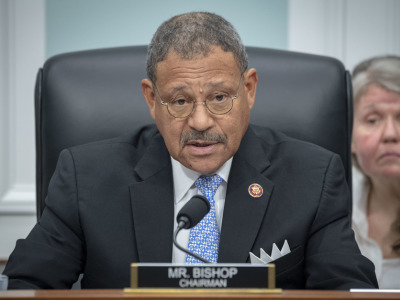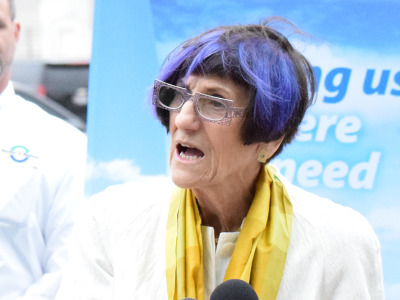House Democrats are rolling out a series of fiscal 2020 spending bills that reject a range of White House spending cuts while challenging key Trump administration priorities and regulatory rollbacks at USDA, EPA and other agencies.
The bills are a long way from becoming law — final spending levels and policy provisions will have to be negotiated with the Senate — but the legislation allows Democrats to lay out their priorities. The new fiscal year starts Oct. 1.
The bills include a number of spending increases in priority programs, ranging from agricultural research to international food aid and EPA enforcement, but those should be read as goals.
House Democrats have yet to reach agreement with the GOP-controlled Senate and the White House on overall spending levels for FY20 defense and domestic spending, and until a deal is struck there also is no agreement on spending limits for the 12 individual bills that fund the departments and agencies as well as operations of the legislative and judicial branches. Failure to reach such an agreement would trigger automatic spending cuts, known as sequestration, under the 2011 Budget Control Act.
The Agriculture bill, which the House Appropriations Committee approved on a party-line 29-21 vote Tuesday, would provide $24.3 billion in FY20 for USDA, FDA and the Commodity Futures Trading Commission, $1 billion more than what was provided for the current year, for so-called “discretionary” programs, whose funding is determined by annual appropriations bills.

House Ag Appropriations Committee Chair Sanford Bishop, D-Ga.
Funding for other programs, including commodity and conservation assistance and the Supplemental Nutrition Assistance Program, is considered “mandatory” because spending levels are set by the farm bill and other laws.
But the top Republican on the House Appropriations Committee, Kay Granger of Texas, said that the spending allocations that Democrats used to write the House bills were “unrealistic” and urged Democrats to reach a spending deal that “prioritizes national security.”
The chairman of the Agriculture Appropriations Subcommittee, Sanford Bishop, D-Ga., said Democrats were following the same process Republicans did when they controlled the committee and there wasn't an agreement on spending limits.
The Senate Appropriations Committee has held off debating its FY20 bills until a budget deal is secured.
The House bills, which are expected to be grouped in packages for floor debate this month, also contain a number of policy provisions that will set up negotiations with the Senate in coming months. The first such package, which is expected to be on the House floor next week, will include the Labor-HHS, Defense, State-Foreign Operations, Energy and Water, and Legislative Branch spending bills.
Included with the bills are nonbinding committee reports that explain various provisions in the bill and urge agencies to take, or avoid, certain actions.
Ag bill prioritizes research, broadband
The Agriculture bill includes spending increases for agricultural research and international food aid and would provide a third round of funding for rural broadband expansion through USDA’s Re-Connect loans and grant program, which was created in FY18. The program would get $550 million for FY20.
USDA’s research programs would receive $3.3 billion, $387 million more than President Trump requested. Research projects funded through the National Institute of Food and Agriculture at universities around the country would be increased by more than $90 million to $1.02 billion. The Agricultural Research Service, which carries out in-house projects, would be increased by $41 million to more than $1.3 billion. The much smaller Sustainable Agriculture Research and Education program would get $45 million, an $8 million increase over FY19.
The nation’s flagship food aid program, Food for Peace, would be funded at $1.85 billion, a $350 million increase from FY19. The McGovern-Dole international school feeding program would be increased by $25 million to $235 million. The White House has tried to kill both programs.
The bill also includes new funding aimed at helping farmers deal with the impact of climate change: $2.5 million to support the work of the National Drought Mitigation Center. The money is intended to help the center respond to an increasing number of drought-related research and operations requests by USDA’s regional climate hubs.
To boost the development of industrial hemp, the bill would provide USDA with $16.5 million to implement provisions in the 2018 farm bill that legalized and promoted production of the crop.
FDA would get an extra $3 million under the bill to offset the cost of revising standards of identities for foods. The standards under review include restrictions on the use of the term “milk” sought by the dairy industry.
Bill seeks to block agency relocations, inspection overhaul
The Ag bill would block Agriculture Secretary Sonny Perdue from moving NIFA and the Economic Research Service from the nation’s capital, but the provision may accomplish little more than sending a message to Perdue. He’s well aware of the House opposition to the relocation plan, but he is expected to announce a new site in the next few weeks and begin moving personnel, long before the bill could be enacted. Unless he has to ask Congress at some point for funding to carry out the move, lawmakers may be unable to stop it.
The bill also would stop Perdue from putting ERS under control of the Office of Chief Economist, a career position. ERS is currently under the purview of the undersecretary for research, education and economics, a politically-appointed position.
An amendment adopted by the Appropriations committee on Tuesday would bar USDA's Food Safety and Inspection Service from implementing a plan to streamline swine inspection until the agency can examine and address a review by the Office of Inspector General of the data used to prepare the plan.
The program, which is similar to one already in place for poultry processors, would move FSIS inspectors off of production lines into microbiological testing duties and allow plants to increase line speeds. "At the very very least we should know whether USDA relied on flawed data" in developing the plan, said Rep. Rosa DeLauro, D-Conn.

Rep. Rosa DeLauro, D-Conn.
Another policy rider included in the draft bill would require USDA to modify the origin of livestock requirements for organic dairy cows. USDA has never finalized changes proposed by the Obama administration in 2015. The rule is needed because cows have been moved in and out of the organic system, mostly so that producers could take advantage of cheaper, nonorganic feed, according to the Organic Trade Association.
Democrats seek to boost Interior, EPA funding
What’s most interesting about the Interior-EPA funding bill may be what’s not in it. Where in the past, the Republican majority had used the bill to explicitly prevent the listing of the greater sage-grouse and the implementation of the Obama-era Clean Water, or WOTUS, rule, the spending bill this time takes a different approach by boosting funding for many regulatory activities.
Interior would receive $13.8 billion, an increase of $833 million, or 6.4%, from the current fiscal year, and $2.41 billion more than President Trump’s request. Included in that is a 15% hike for the Fish and Wildlife Service’s Ecological Services program, which includes money for endangered species enforcement.
EPA would get $9.52 billion, a 7.5% increase from FY19 and current fiscal year and a whopping 56% more than the White House proposed. EPA would get $511 million for compliance monitoring and enforcement activities, a $40 million increase above the 2019 enacted level and $63 million above the president’s request.
The bills also would provide EPA regional programs that provide money for protecting the Great Lakes, Chesapeake Bay and other water bodies. The Trump administration had sought to end the funding. The programs would get $476 million, a $19 million increase over the current year.
The Land and Water Conservation Fund would get $523.9 million, an $85 million increase over FY19.
The nonbinding House committee report urges EPA to finish developing an “accurate, robust, and accessible” methodology for estimating emissions from animal feeding operations. The Interior Department is directed to work with USDA as well as states and private organizations on strategies to protect monarch butterflies, including setting up milkweed reserves.
Democratic appropriators also are urging Interior to preserve state and federal sage-grouse plans covering 11 western states. "This administration is moving forward with revisions that will weaken protections and conservation prescriptions for sage-grouse that were included in the 2015 science-based greater sage grouse strategy,” the committee report says.
Bill extends ELD exemption for livestock haulers
The FY20 Transportation-HUD bill, which the Appropriations committee also approved Tuesday, would extend a temporary exemption for livestock haulers from requirements to have electronic logging devices. The current exemption expires Sept. 30.
The ELDs would be used to enforce hours-of-service requirements that the livestock industry is trying to get changed.
Ports, waterways would get funding boost

Mike Steenhoek, Soy Transportation Coalition
Agriculture and shipping industry officials say the $357 million funding increase for the U.S. Army Corps of Engineers in the Energy-Water bill would provide needed momentum to maintain and improve the nation’s inland waterway system. The bill contains $7.3 billion for the Army Corps to pay for construction and maintenance projects and adds six new studies and six projects.
“We’re seeing this positive momentum occur, but the real key is maintaining that,” said Mike Steenhoek, executive director of the Soy Transportation Coalition. He added there has been a significant increase in funding for the Army Corps over last five years, “nearly a 50 percent increase” and said there’s even been bipartisan support.
The bill makes use of all estimated annual revenues from the Inland Waterways Trust Fund, but the Waterways Council, a coalition of shippers and the barge industry, says the number is too low. “Every year, they continue to lowball the revenues," said Tracy Zea, vice president of government relations for the Waterways Council. The trust fund should provide around $118 million for FY20 rather than the $107 million in revenues that the White House expects.
Farmworker aid increased
The Labor-HHS spending bill would increase funding for migrant and seasonal farmworkers by $10 million from last year to $98 million in FY20. The president’s budget proposes to eliminate the program.
The bill also would fund for the first time, farmworker youth activities, outlined in the Workforce Innovation and Opportunity Act. It also moves the funding availability date from July 1 to April 1 to allow for grants to be distributed in a more-timely manner.
This bill also maintains $317 million for rural health which is $128 million more than the president’s request of $189 million.
For more news, go to Agri-Pulse.com.




